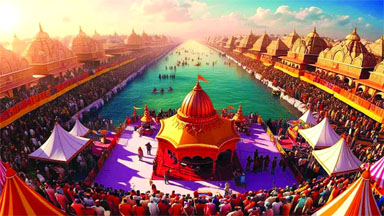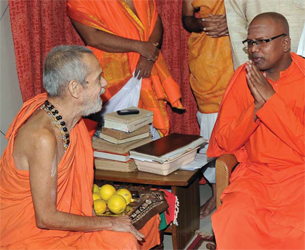
The Mahakumbh Mela, set to unfold in Prayagraj on January 13, 2025, stands as one of the world’s largest and most profound gatherings of faith. Held every 12 years at the sacred Triveni Sangam-the confluence of the Ganga, Yamuna, and the mystical Saraswati rivers-this event transcends religious boundaries and showcases the rich spiritual and cultural heritage of India.
The Legend Behind the Mahakumbh
The origin of the Kumbh Mela is rooted in the Puranic story of the Samudra Manthan (churning of the ocean) by the devas (gods) and asuras (demons). According to Hindu mythology, during the churning, a pot (kumbh) of amrita (nectar of immortality) emerged. To prevent the nectar from falling into the hands of the asuras, the devas carried it away. In the ensuing chase, drops of amrita fell at four places: Prayagraj, Haridwar, Ujjain, and Nashik. These locations became sanctified, and the Kumbh Mela is celebrated to commemorate this divine event. Prayagraj holds a special place among these sites as it is where the three sacred rivers meet, symbolizing unity and purification.
Traditions and Rituals of the Mahakumbh
The Mahakumbh Mela is marked by a range of spiritual practices that draw millions of devotees, sadhus, and pilgrims from all corners of the globe. Key rituals and traditions include:
– Shahi Snan (Royal Bath): The most significant ritual of the Mahakumbh, the Shahi Snan, involves taking a dip in the holy waters of the Sangam. This act is believed to cleanse the soul of sins and pave the way for moksha (liberation).
– Akharas and Sadhus: The Akharas, or monastic orders of ascetics, play a vital role in the Kumbh Mela. Naga sadhus (naked ascetics), Urdhwavahurs (those who practice severe austerities), and Parivrajakas (wandering monks) showcase their spiritual discipline and lead the processions to the Sangam.
– Ganga Aarti: The mesmerizing Ganga Aarti, performed at the banks of the river, is a visual and spiritual treat. Devotees light lamps and chant hymns, creating a divine atmosphere.
– Spiritual Discourses and Cultural Programs: The Mahakumbh serves as a platform for spiritual leaders, scholars, and artists to share wisdom and perform, fostering an exchange of ideas and cultural expressions.
Origins and Evolution
The Kumbh Mela’s documented history dates back to ancient scriptures such as the Rigveda, which mentions river confluences as sacred. The significance of Prayagraj as a tirtha (pilgrimage site) is highlighted in texts like the Mahabharata and the Puranas. Over centuries, the Kumbh Mela evolved from a localized festival into a global phenomenon. It was institutionalized during the reign of Emperor Harsha in the 7th century CE and gained prominence under the guidance of Adi Shankaracharya, who united various ascetic orders to participate in the event.
Mahakumbh 2025: A Global Phenomenon
The Mahakumbh of 2025 is expected to be a grand spectacle, with advanced preparations to accommodate millions of devotees. The government and local authorities are working tirelessly to ensure infrastructure, sanitation, and safety measures are in place. With technology integration, live streaming, and mobile apps, the event aims to reach a global audience while preserving its traditional essence.
Maha Kumbh Mela: Astrological and Cultural Significance
The Maha Kumbh Mela is based on different astrological conditions at each place, which are determined by the position of the Sun, Moon, and Jupiter. The festival is celebrated when the position of these planets attains perfection, which is considered a very holy time in Hinduism. The Kumbh Mela is a wonderful amalgamation of astronomy, astrology, spirituality, ritual traditions and socio-cultural customs, making the event a symbol of profound knowledge. The Kumbh Mela attracts people from all religions, including sadhus, Naga sadhus, sanyasis and common devotees. Naga sadhus and sanyasis follow intense sadhana and spiritual discipline and come into public life only during the Kumbh Mela. At the same time, spiritualists and common people who follow Hinduism also attend the fair in large numbers.
There are many special events in the Kumbh Mela. The traditional procession of the Akharas, called ‘Peshwai’, is taken out with elephants, horses and chariots. The performance of Naga sadhus during the ‘Shahi Snan’, their gleaming swords and traditional rituals, besides several cultural activities attract lakhs of devotees to the fair.
The Mahakumbh Mela of Prayagraj is more than a religious event; it is a celebration of humanity’s quest for the divine. It brings together faith, tradition, and community, offering a unique opportunity for spiritual rejuvenation and cultural immersion. As the world converges at the sacred Sangam in 2025, the Mahakumbh promises to be a beacon of hope, unity, and timeless wisdom.





1 Trackback / Pingback